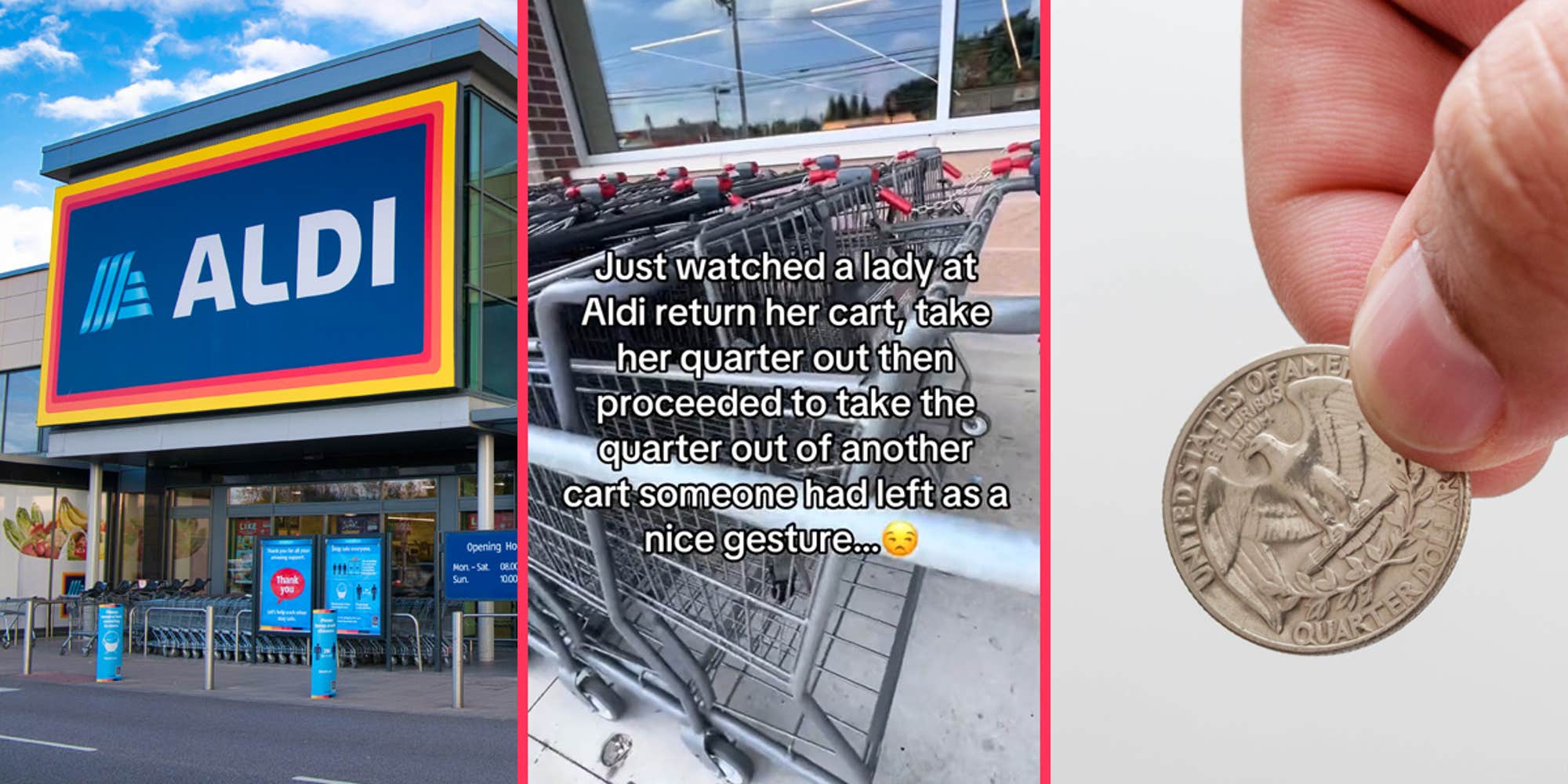Unique Shopping Experience
If you’ve ever shopped at Aldi, you’ve probably noticed something unusual right outside the store: rows of shopping carts chained together, requiring a 25-cent deposit to unlock one. For new shoppers, this may seem strange—why would a grocery store make customers pay to use a cart?
But this small detail reveals one of Aldi’s smartest business strategies. Far from being a simple gimmick, the Aldi cart deposit system plays an important role in how the company keeps prices low, stores organized, and the shopping experience efficient.
Let’s explore how this simple, quarter-based approach benefits both Aldi and its customers.

Encouraging Cart Returns and Cleaner Parking Lots
At most grocery stores, shopping carts often end up scattered across parking lots. Employees have to spend hours collecting them, which adds to labor costs and sometimes causes inconvenience for drivers.
Aldi’s system solves this problem elegantly. To use a cart, shoppers insert a quarter into the locking mechanism, which releases it for use. When they finish shopping and return the cart to its proper spot, the quarter pops back out.
This small financial incentive encourages shoppers to take responsibility for returning carts. As a result, Aldi parking lots tend to stay cleaner and more organized, without the need for staff to constantly collect abandoned carts.
According to retail analysts, the system also reduces the risk of cart damage and theft — saving the company significant costs that would otherwise be passed on to customers.

Keeping Prices Low for Everyone
Aldi’s commitment to affordability is central to its brand identity. The company’s cart deposit system is one of many ways it keeps operational costs low and passes those savings directly to shoppers.
Replacing damaged or lost carts can cost hundreds of dollars each, especially when multiplied across hundreds of store locations. By making customers responsible for returning carts, Aldi reduces these replacement costs dramatically.
Those savings don’t just help the company—they’re reflected in Aldi’s famously low prices on groceries, produce, and household essentials. Every efficiency, no matter how small, contributes to the company’s cost-saving business model that allows it to undercut competitors while maintaining quality.

Reducing Labor Costs and Boosting Efficiency
In traditional supermarkets, employees are often tasked with collecting stray carts from the parking lot. While it seems like a minor task, it consumes time that could be better spent assisting customers, stocking shelves, or managing checkout lines.
At Aldi, because shoppers return their own carts, store employees can focus entirely on store operations. This improves staff productivity and ensures the store runs smoothly even with fewer employees.
In fact, Aldi is known for maintaining lean, efficient teams. Every policy — from self-bagging groceries to the cart deposit system — is designed to make each minute of employee time count. That efficiency allows Aldi to pay competitive wages while keeping prices consistently low, creating a win-win for both staff and customers.
Promoting Responsibility and Sustainability
Aldi’s business practices often reflect values of accountability and sustainability. Just like its policy of charging a small fee for grocery bags, the cart deposit encourages responsible consumer behavior.
When shoppers bring their own bags and return their carts, they help reduce waste and unnecessary labor. It’s a subtle but effective way of fostering a sense of community cooperation — everyone contributes a little to keep the store running efficiently.
Environmental advocates also appreciate the system because it discourages unnecessary production and disposal of carts, which are made from metal and plastic. By reducing cart loss, Aldi minimizes waste and conserves resources over time.

How the Aldi Cart System Works
For those new to Aldi, here’s how the process works step by step:
-
Insert a Quarter: When you arrive, you’ll find carts connected by a small chain. Insert a quarter into the lock on the handle to release a cart.
-
Shop as Usual: Enjoy your shopping experience. Aldi’s stores are designed for efficiency, with clearly labeled aisles and streamlined layouts.
-
Return the Cart: When you’re done, simply bring your cart back to the designated area.
-
Get Your Quarter Back: Reattach the chain to lock the cart, and your quarter will be automatically released.
It’s quick, simple, and fair. Best of all, Aldi doesn’t profit from this system. The deposit is fully refundable, meaning the quarter is simply a temporary reminder to return your cart — not a fee.
A System That Reflects Aldi’s Core Philosophy
Aldi’s cart system might seem like a small detail, but it reflects the company’s broader mission: to deliver high-quality products at the lowest possible prices. Every part of its operation — from smaller store footprints to efficient product displays — supports that goal.
Here are a few other examples of Aldi’s cost-saving strategies that align with the cart deposit idea:
-
No free bags: Shoppers are encouraged to bring reusable bags or purchase them at checkout, reducing plastic waste.
-
Simple store design: Aldi stores use straightforward layouts and display products in shipping boxes to save time on stocking.
-
Limited product selection: By offering a curated range of products, Aldi reduces overhead costs and simplifies inventory management.
-
Private-label brands: Most Aldi products are in-house brands that deliver quality comparable to national names at a fraction of the cost.
Together, these choices create a consistent experience — simple, efficient, and budget-friendly.
Why Shoppers Appreciate the System
While some first-time visitors might be surprised by the cart deposit rule, many regular customers see it as part of what makes Aldi unique.
The system adds a sense of mutual respect and shared responsibility among shoppers. Everyone plays a small part in keeping the store clean and efficient, and in return, everyone benefits from lower prices and a smoother experience.
The fact that you get your quarter back reinforces that Aldi’s approach isn’t about profit — it’s about partnership between the store and its customers.
The Bigger Picture: A Small Idea with Big Impact
Aldi’s cart system has become so effective that other discount retailers around the world have adopted similar models. It’s a perfect example of how a small behavioral incentive can lead to major operational improvements and long-term savings.
It’s also a lesson in how simplicity can drive success. Rather than relying on expensive technology or complex logistics, Aldi focuses on straightforward, practical ideas that make sense for both the company and its shoppers.
In an era where many retailers struggle with rising costs and staffing challenges, Aldi’s cart deposit system remains a model of efficiency — proving that sometimes, the smartest innovations are the simplest ones.

Conclusion
What started as a quirky feature has turned into one of Aldi’s most recognized and admired strategies. The 25-cent cart deposit system may seem minor, but it embodies Aldi’s entire philosophy of affordability, responsibility, and efficiency.
By encouraging customers to return carts, Aldi keeps its stores tidy, reduces labor and replacement costs, and maintains its promise of low prices without compromise.
So the next time you slip a quarter into an Aldi cart, remember: it’s not just a deposit — it’s a symbol of how small actions, when done collectively, can make a big difference for everyone.




